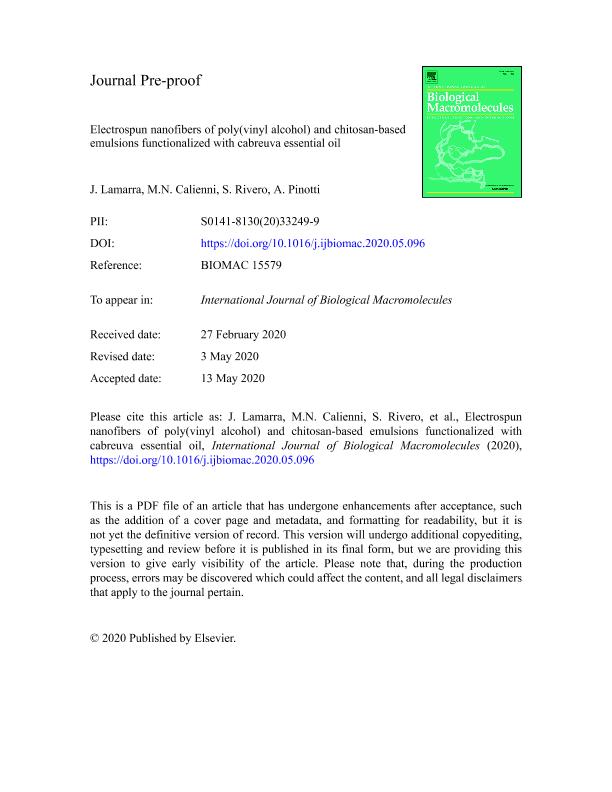Mostrar el registro sencillo del ítem
dc.contributor.author
Lamarra, Javier Andres

dc.contributor.author
Calienni, Maria Natalia

dc.contributor.author
Rivero, Sandra G. M.

dc.contributor.author
Pinotti, Adriana Noemi

dc.date.available
2021-08-30T15:44:32Z
dc.date.issued
2020-10
dc.identifier.citation
Lamarra, Javier Andres; Calienni, Maria Natalia; Rivero, Sandra G. M.; Pinotti, Adriana Noemi; Electrospun nanofibers of poly(vinyl alcohol) and chitosan-based emulsions functionalized with cabreuva essential oil; Elsevier Science; International Journal of Biological Macromolecules; 160; 10-2020; 307-318
dc.identifier.issn
0141-8130
dc.identifier.uri
http://hdl.handle.net/11336/139208
dc.description.abstract
Among the essential oils (EOs), the cabreuva essential oil extracted from the wood of Myrocarpus fastigiatus, is a promising compound for potential applications in the field of pharmaceuticals and food packaging. To overcome the low solubility of cabreuva EO and to protect it, a two-step process, emulsion formation compound by chitosan, SDS, and PVA, and subsequent ionic crosslinking with sodium citrate, was proposed. The formulation containing 0.75% of chitosan and 1% of SDS proved to be the most stable. An alternative to produce nanostructures and encapsulate the EO is the fiber formation through the electrospinning method. The system composed by a PVA solution assembled with crosslinked emulsions modified the viscosity, influencing the morphology of the obtained nanofibers. The advantage of the electrospun nanofibers was their ability to be an effective carrier of the cabreuva EO and the capacity of controlling the compound release that proved an effective activity against broad spectra of micro-organisms (Candida albicans, E. coli, S. aureus, and S. epidermidis). The Gallagher-Corrigan model, used to fit the release profiles of matrices in contact with increasing ethanol proportion from 25:75 to 50:50 showed higher Kb in relation to k suggesting that the polymer swelling played an increasingly prominent role in the EO delivery. The developed nanostructures would be materials with potential applications in the biomedical field.
dc.format
application/pdf
dc.language.iso
eng
dc.publisher
Elsevier Science

dc.rights
info:eu-repo/semantics/openAccess
dc.rights.uri
https://creativecommons.org/licenses/by-nc-nd/2.5/ar/
dc.subject
CABREUVA ESSENTIAL OIL
dc.subject
CHITOSAN
dc.subject
CONTROLLED RELEASE
dc.subject
ELECTROSPINNING
dc.subject.classification
Recubrimientos y Películas

dc.subject.classification
Ingeniería de los Materiales

dc.subject.classification
INGENIERÍAS Y TECNOLOGÍAS

dc.title
Electrospun nanofibers of poly(vinyl alcohol) and chitosan-based emulsions functionalized with cabreuva essential oil
dc.type
info:eu-repo/semantics/article
dc.type
info:ar-repo/semantics/artículo
dc.type
info:eu-repo/semantics/publishedVersion
dc.date.updated
2021-08-27T20:46:33Z
dc.identifier.eissn
1879-0003
dc.journal.volume
160
dc.journal.pagination
307-318
dc.journal.pais
Países Bajos

dc.journal.ciudad
Amsterdam
dc.description.fil
Fil: Lamarra, Javier Andres. Provincia de Buenos Aires. Gobernación. Comisión de Investigaciones Científicas. Centro de Investigación y Desarrollo en Criotecnología de Alimentos. Consejo Nacional de Investigaciones Científicas y Técnicas. Centro Científico Tecnológico Conicet - La Plata. Centro de Investigación y Desarrollo en Criotecnología de Alimentos. Universidad Nacional de La Plata. Facultad de Ciencias Exactas. Centro de Investigación y Desarrollo en Criotecnología de Alimentos; Argentina
dc.description.fil
Fil: Calienni, Maria Natalia. Consejo Nacional de Investigaciones Científicas y Técnicas. Centro Científico Tecnológico Conicet - La Plata. Instituto Multidisciplinario de Biología Celular. Grupo Vinculado al IMBICE - Grupo de Biología Estructural y Biotecnología - Universidad Nacional de Quilmes - GBEyB | Provincia de Buenos Aires. Gobernación. Comisión de Investigaciones Científicas. Instituto Multidisciplinario de Biología Celular. Grupo Vinculado al IMBICE - Grupo de Biología Estructural y Biotecnología - Universidad Nacional de Quilmes - GBEyB | Universidad Nacional de La Plata. Instituto Multidisciplinario de Biología Celular. Grupo Vinculado al IMBICE - Grupo de Biología Estructural y Biotecnología - Universidad Nacional de Quilmes - GBEyB; Argentina
dc.description.fil
Fil: Rivero, Sandra G. M.. Provincia de Buenos Aires. Gobernación. Comisión de Investigaciones Científicas. Centro de Investigación y Desarrollo en Criotecnología de Alimentos. Consejo Nacional de Investigaciones Científicas y Técnicas. Centro Científico Tecnológico Conicet - La Plata. Centro de Investigación y Desarrollo en Criotecnología de Alimentos. Universidad Nacional de La Plata. Facultad de Ciencias Exactas. Centro de Investigación y Desarrollo en Criotecnología de Alimentos; Argentina
dc.description.fil
Fil: Pinotti, Adriana Noemi. Provincia de Buenos Aires. Gobernación. Comisión de Investigaciones Científicas. Centro de Investigación y Desarrollo en Criotecnología de Alimentos. Consejo Nacional de Investigaciones Científicas y Técnicas. Centro Científico Tecnológico Conicet - La Plata. Centro de Investigación y Desarrollo en Criotecnología de Alimentos. Universidad Nacional de La Plata. Facultad de Ciencias Exactas. Centro de Investigación y Desarrollo en Criotecnología de Alimentos; Argentina
dc.journal.title
International Journal of Biological Macromolecules

dc.relation.alternativeid
info:eu-repo/semantics/altIdentifier/url/https://bit.ly/2WCmNJm
dc.relation.alternativeid
info:eu-repo/semantics/altIdentifier/doi/http://dx.doi.org/10.1016/j.ijbiomac.2020.05.096
Archivos asociados
